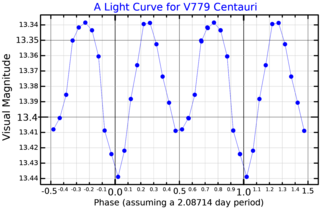
Centaurus X-3 is an X-ray pulsar with a period of 4.84 seconds. It was the first X-ray pulsar to be discovered, and the third X-ray source to be discovered in the constellation Centaurus. The system consists of a neutron star orbiting a massive, O-type supergiant star dubbed Krzemiński's star after its discoverer, Wojciech Krzemiński. Matter is being accreted from the star onto the neutron star, resulting in X-ray emission.

IU Aurigae is a triple star system in the constellation Auriga, consisting of an eclipsing binary pair orbiting a third component with a period of 335 years. This system is too faint to be viewed with the naked eye, having a peak apparent visual magnitude of 8.19.

68 Herculis is a triple star system located around 950 light-years away from the Sun in the northern constellation of Hercules. In the astronomical community it is often referred to by its Bayer designation of u Herculis, while 68 Herculis is the Flamsteed designation. The system is visible to the naked eye as a faint, blue-white-hued point of light with a peak apparent visual magnitude of 4.80. It is approaching the Earth with a heliocentric radial velocity of −17 km/s.
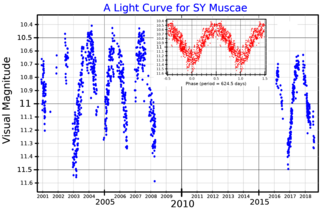
SY Muscae is a binary star system in the constellation Musca composed of a red giant and a white dwarf. Its apparent magnitude varies from 10.2 to 12.7 over a period of 624.5 days. Although the binary is a symbiotic star system, it is unusual in that it does not have an eruptive component. It is an S-type symbiotic system, which means that the light comes from the stars rather than surrounding dust.

W Crucis is a single-lined eclipsing variable star system in the constellation Crux. It has a spectral class of F8/G1Ia/abe indicating a yellow supergiant with emission lines in its spectrum.

V1400 Centauri, also known as 1SWASP J140747.93−394542.6 or simply J1407, is a young, pre-main-sequence star that was eclipsed by the likely free-floating substellar object J1407b in April–June 2007. With an age around 20 million years, the star is about as massive as the Sun and is located in the constellation Centaurus at a distance of 451 light-years away from the Sun. V1400 Centauri is a member of Upper Centaurus–Lupus subgroup of the Scorpius–Centaurus association, a group of young, comoving stars close to the Sun.

RR Centauri is a variable star with an apparent magnitude of +7.29 when it is at its brightest. It is located in the constellation of Centaurus, approximately 320 light years distant from the solar system.

W Aquilae is a variable star in the constellation of Aquila. It is a type of evolved star known as an S-type star. Due to its relatively close distance of 1,200 light-years and equatorial location, it is easy to observe and heavily studied.

HO Telescopii is an eclipsing binary star system located in the southern constellation of Telescopium. The maximum apparent visual magnitude of 8.22 is too faint to be visible to the naked eye. The system is located at a distance of approximately 910 light years based on parallax. The combined stellar classification of the system is A7III(m), matching an evolved A-type star that is possibly metallic-lined. The system is around 1.1 billion years old and consists of two stars of similar mass and size.

BV Centauri is a cataclysmic variable binary star in the constellation Centaurus. It is a dwarf nova, and undergoes rapid increases in brightness that are recurrent with a mean period of 150 days. This period seems to have increased in the last few decades. During quiescence, its visual apparent magnitude is about 13, with variations of a few tenths of magnitude over an orbit due to differences in the star's visible surface area, brightening to a maximum magnitude of 10.7 during outbursts. From its luminosity, it is estimated that the system is about 500 parsecs (1,600 ly) away from Earth. A Gaia parallax of 2.81 mas has been measured, corresponding to about 360 pc. William Francis Herschel Waterfield discovered that the star is a variable star, in 1929.
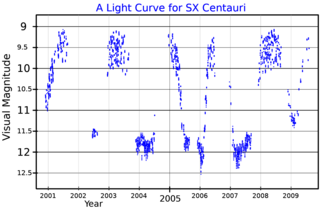
SX Centauri is a variable star in the constellation Centaurus. An RV Tauri variable, its light curve alternates between deep and shallow minima, varying its apparent magnitude from 9.1 to 12.4. From the period-luminosity relationship, it is estimated to be around 1.6 kpc from Earth. Gaia Data Release 2 gives a parallax of 0.2175 mas, corresponding to distance of about 4,600 pc. Henrietta Leavitt announced the discovery of this variable star, in 1906, when it was called CPD-48° 4730. It was given its variable star designation, SX Centauri, in 1907.

AD Andromedae is an eclipsing binary in the constellation Andromeda. Its maximum apparent visual magnitude is 11.2, but it shows a decrease of 0.62 magnitudes during the main eclipse and 0.58 during the secondary one. It is classified as a Beta Lyrae variable star with a period of almost one day.

EG Andromedae is a symbiotic binary in the constellation Andromeda. Its apparent visual magnitude varies between 6.97 and 7.80.
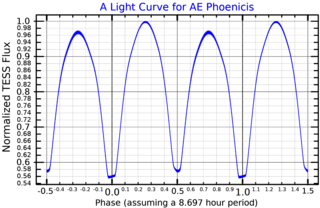
AE Phoenicis is a variable star in the constellation of Phoenix. An eclipsing binary, its apparent magnitude has a maximum of 7.56, dimming to 8.25 during primary eclipse and 8.19 during secondary eclipse. From parallax measurements by the Gaia spacecraft, the system is located at a distance of 168 light-years from Earth.

V752 Centauri is multiple star system and variable star in the constellation of Centaurus. An eclipsing binary, its apparent magnitude has a maximum of 9.10, dimming to 9.66 during primary eclipse and 9.61 during secondary eclipse. Its variability was discovered by Howard Bond in 1970. From parallax measurements by the Gaia spacecraft, the system is located at a distance of 410 light-years from Earth.

AO Serpentis is an eclipsing binary star system in the Serpens Caput segment of the Serpens constellation. It is invisible to the naked eye with a typical apparent visual magnitude of 11.04. Variable star observers record a peak magnitude of 10.7, dropping to 12.0 during the primary eclipse and 10.8 from the secondary eclipse. The distance to this system is approximately 1,450 light years based on parallax measurements.

V346 Centauri is a variable star in the constellation Centaurus. An Algol-type eclipsing binary, its apparent magnitude has a maximum of 8.50, dropping to 8.77 during primary eclipse and to 8.72 during secondary eclipse, the latter being a total eclipse. From parallax measurements by the Gaia spacecraft, the system is located at a distance of about 2300 parsecs (7400 light-years), which is consistent with earlier estimates, based on its luminosity, of 2380 parsecs. The system is a confirmed member of the open cluster Stock 14, which contains many other young OB stars.

RS Sagittarii is an eclipsing binary star system in the southern constellation of Sagittarius, abbreviated RS Sgr. It is a double-lined spectroscopic binary with an orbital period of 2.416 days, indicating that the components are too close to each other to be individually resolved. The system has a combined apparent visual magnitude of 6.01, which is bright enough to be faintly visible to the naked eye. During the primary eclipse the brightness drops to magnitude 6.97, while the secondary eclipse is of magnitude 6.28. The distance to this system is approximately 1,420 light years based on parallax measurements.
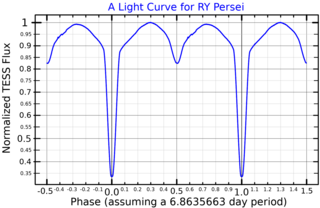
RY Persei is a variable star in the northern constellation of Perseus, abbreviated RY Per. It is an Algol variable with a period of 6.8635663 days, which indicates this is an eclipsing binary star system with an orbital plane oriented close to the line of sight from the Earth. The system has a maximum apparent visual magnitude of 8.50, which drops down to magnitude 10.25 during the eclipse of the primary component, then to 8.65 with the secondary eclipse. Based on parallax measurements, this system is located at a distance of approximately 2,960 light years from the Sun, but is drifting closer with a radial velocity of −12 km/s.

RT Persei is a variable star system in the northern constellation of Perseus, abbreviated RT Per. It is an eclipsing binary system with an orbital period of 0.84940032 d (20.386 h). At peak brightness the system has an apparent visual magnitude of 10.46, which is too faint to be viewed with the naked eye. During the eclipse of the primary this decreases to magnitude 11.74, then to magnitude 10.67 with the secondary eclipse. The distance to this system is approximately 628 light years based on parallax measurements. It is drifting closer with a heliocentric radial velocity of about −12 km/s.




















